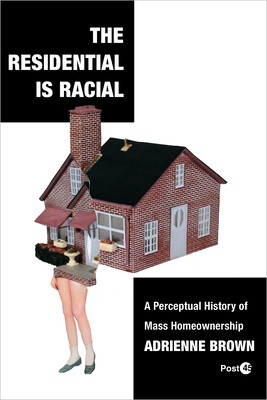
- We will send in 10–14 business days.
- Author: Adrienne Brown
- Publisher: Stanford University Press
- ISBN-10: 1503638642
- ISBN-13: 9781503638648
- Format: 15.2 x 22.9 x 2.3 cm, softcover
- Language: English
- SAVE -10% with code: EXTRA
Reviews
Description
Housing experts and activists have long described the foundational role race has played in the creation of mass homeownership. This book insistently tracks the inverse: the role of mass homeownership in changing the definition, perception, and value of race.
In The Residential is Racial Brown reveals how mass homeownership remade the rubrics of race, from the early cases realtors made for homeownership's necessity to white survival through the passage of the 1968 passage of the Fair Housing Act. Reading real estate archives and appraisal textbooks alongside literary works by F. Scott Fitzgerald, John Steinbeck, Lorraine Hansberry, Richard Wright, Gwendolyn Brooks, James Baldwin, Ralph Ellison, John Cheever, and Thomas Pynchon, Brown goes beyond merely identifying the discriminatory mechanisms that the real estate industry used to forestall black homeownership. Rather, she reveals that redlining and other forms of racial discrimination are perceptual modes, changing what it meant to sense race and assign it value.
Resituating residential discrimination as a key moment within the history of perception and aesthetics as well as of policy, demography, and democracy, we get an even more expansive picture of both its origins and its impacts. This book discovers that the racial honing of the residential perception--seeing race like a bureaucrat, an appraiser, and a homeowning neighbor--has become central to the functioning of the residential itself.
EXTRA 10 % discount with code: EXTRA
The promotion ends in 17d.14:36:58
The discount code is valid when purchasing from 10 €. Discounts do not stack.
- Author: Adrienne Brown
- Publisher: Stanford University Press
- ISBN-10: 1503638642
- ISBN-13: 9781503638648
- Format: 15.2 x 22.9 x 2.3 cm, softcover
- Language: English English
Housing experts and activists have long described the foundational role race has played in the creation of mass homeownership. This book insistently tracks the inverse: the role of mass homeownership in changing the definition, perception, and value of race.
In The Residential is Racial Brown reveals how mass homeownership remade the rubrics of race, from the early cases realtors made for homeownership's necessity to white survival through the passage of the 1968 passage of the Fair Housing Act. Reading real estate archives and appraisal textbooks alongside literary works by F. Scott Fitzgerald, John Steinbeck, Lorraine Hansberry, Richard Wright, Gwendolyn Brooks, James Baldwin, Ralph Ellison, John Cheever, and Thomas Pynchon, Brown goes beyond merely identifying the discriminatory mechanisms that the real estate industry used to forestall black homeownership. Rather, she reveals that redlining and other forms of racial discrimination are perceptual modes, changing what it meant to sense race and assign it value.
Resituating residential discrimination as a key moment within the history of perception and aesthetics as well as of policy, demography, and democracy, we get an even more expansive picture of both its origins and its impacts. This book discovers that the racial honing of the residential perception--seeing race like a bureaucrat, an appraiser, and a homeowning neighbor--has become central to the functioning of the residential itself.


Reviews